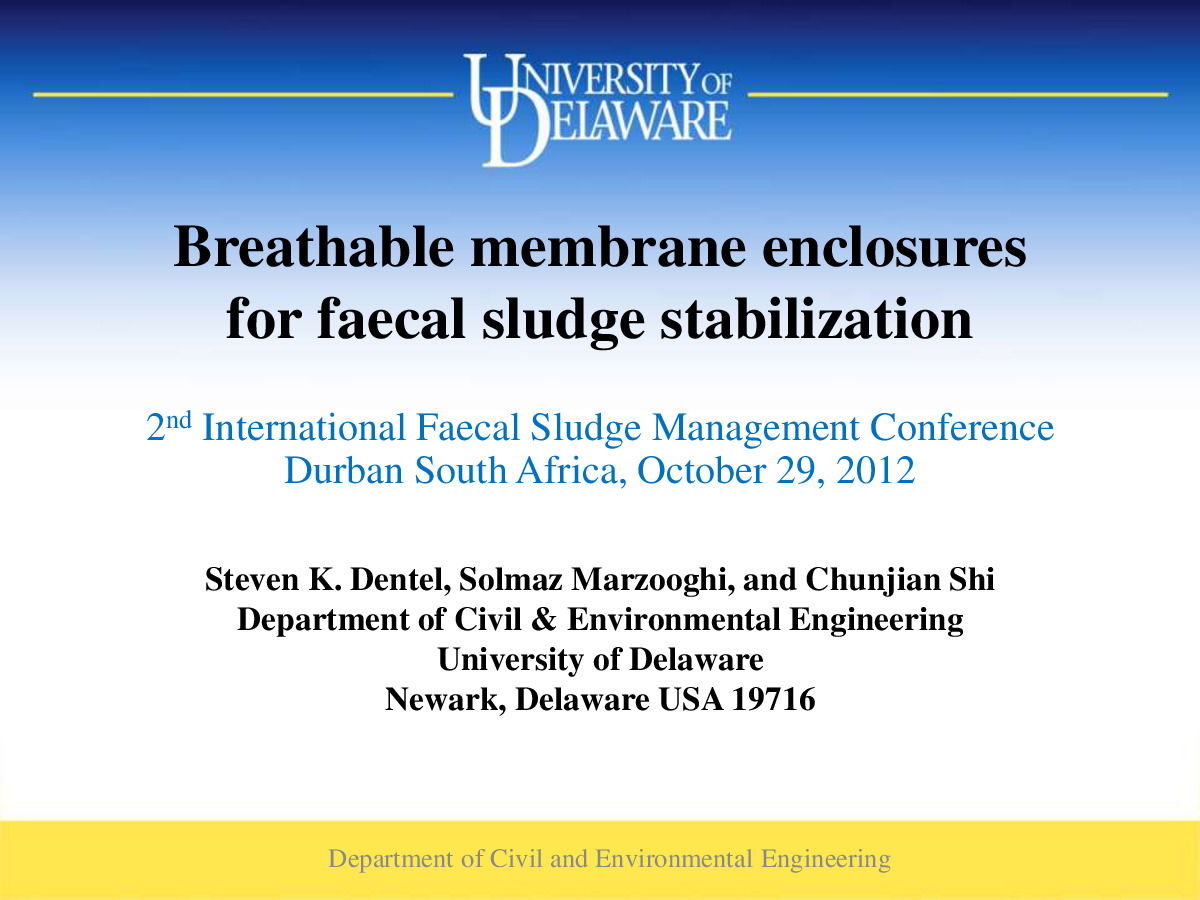-
Containment Collection and transport Treatment Disposal / Reuse
-
Capacity building Finance Information Education and Communication / Behavior Change Communication Infrastructure Policy and processes Technology
-
Access to sanitary toilets Better governance and planning Change in disease burden Collection efficiency of sanitation system Cost recovery Environmental sustainability through reuse, resource recovery, conservation Equity and social inclusion Private sector engagement Quantity of waste safely treated Sanitation practices of the supply side Sanitation practices of the end user
-
Unclogging the Blockages in Sanitation - Conference materials
Conference Themes: The Action ExchangeUnclogging the Blockages is about action. The action exchange was organized according to several themes (several are listed below) with experts from each of these subject areas presenting and leading small group discussions with their peers on what are the main challenges and barriers for moving forward. After these initial discussions, the challenges were be presented to larger mixed groups and a facilitated discussion took place to find solutions. These discussions were also oriented towards skill and knowledge transfer for the uninitiated. Participants left the meeting with specific action plans and ideas to test.- Starting Social Enterprises in Sanitation- Linking CLTS with Sanitation as a Business- Systems and Tools for Direct Sales- Business Development Services and Accelerators- Social and Commercial Sanitation Investment- Micro Finance and Effective Sanitation Financial Products- Technology, R&D, Product Development, and Supply Chain- Public Sector Roles- Monitoring and Data Sharing- Health and Hygiene- Urban Tools- Fecal Sludge and Solid Waste Management- Reuse and Energy
-
Unclogging the Blockages in Sanitation - Conference materials
Conference Themes: The Action ExchangeUnclogging the Blockages is about action. The action exchange was organized according to several themes (several are listed below) with experts from each of these subject areas presenting and leading small group discussions with their peers on what are the main challenges and barriers for moving forward. After these initial discussions, the challenges were be presented to larger mixed groups and a facilitated discussion took place to find solutions. These discussions were also oriented towards skill and knowledge transfer for the uninitiated. Participants left the meeting with specific action plans and ideas to test.- Starting Social Enterprises in Sanitation- Linking CLTS with Sanitation as a Business- Systems and Tools for Direct Sales- Business Development Services and Accelerators- Social and Commercial Sanitation Investment- Micro Finance and Effective Sanitation Financial Products- Technology, R&D, Product Development, and Supply Chain- Public Sector Roles- Monitoring and Data Sharing- Health and Hygiene- Urban Tools- Fecal Sludge and Solid Waste Management- Reuse and Energy
-
Unclogging the Blockages in Sanitation - Conference materials
Conference Themes: The Action ExchangeUnclogging the Blockages is about action. The action exchange was organized according to several themes (several are listed below) with experts from each of these subject areas presenting and leading small group discussions with their peers on what are the main challenges and barriers for moving forward. After these initial discussions, the challenges were be presented to larger mixed groups and a facilitated discussion took place to find solutions. These discussions were also oriented towards skill and knowledge transfer for the uninitiated. Participants left the meeting with specific action plans and ideas to test.- Starting Social Enterprises in Sanitation- Linking CLTS with Sanitation as a Business- Systems and Tools for Direct Sales- Business Development Services and Accelerators- Social and Commercial Sanitation Investment- Micro Finance and Effective Sanitation Financial Products- Technology, R&D, Product Development, and Supply Chain- Public Sector Roles- Monitoring and Data Sharing- Health and Hygiene- Urban Tools- Fecal Sludge and Solid Waste Management- Reuse and Energy
-
Unclogging the Blockages in Sanitation - Conference materials
Conference Themes: The Action ExchangeUnclogging the Blockages is about action. The action exchange was organized according to several themes (several are listed below) with experts from each of these subject areas presenting and leading small group discussions with their peers on what are the main challenges and barriers for moving forward. After these initial discussions, the challenges were be presented to larger mixed groups and a facilitated discussion took place to find solutions. These discussions were also oriented towards skill and knowledge transfer for the uninitiated. Participants left the meeting with specific action plans and ideas to test.- Starting Social Enterprises in Sanitation- Linking CLTS with Sanitation as a Business- Systems and Tools for Direct Sales- Business Development Services and Accelerators- Social and Commercial Sanitation Investment- Micro Finance and Effective Sanitation Financial Products- Technology, R&D, Product Development, and Supply Chain- Public Sector Roles- Monitoring and Data Sharing- Health and Hygiene- Urban Tools- Fecal Sludge and Solid Waste Management- Reuse and Energy
-
Unclogging the Blockages in Sanitation - Conference materials
Conference Themes: The Action ExchangeUnclogging the Blockages is about action. The action exchange was organized according to several themes (several are listed below) with experts from each of these subject areas presenting and leading small group discussions with their peers on what are the main challenges and barriers for moving forward. After these initial discussions, the challenges were be presented to larger mixed groups and a facilitated discussion took place to find solutions. These discussions were also oriented towards skill and knowledge transfer for the uninitiated. Participants left the meeting with specific action plans and ideas to test.- Starting Social Enterprises in Sanitation- Linking CLTS with Sanitation as a Business- Systems and Tools for Direct Sales- Business Development Services and Accelerators- Social and Commercial Sanitation Investment- Micro Finance and Effective Sanitation Financial Products- Technology, R&D, Product Development, and Supply Chain- Public Sector Roles- Monitoring and Data Sharing- Health and Hygiene- Urban Tools- Fecal Sludge and Solid Waste Management- Reuse and Energy
-
Unclogging the Blockages in Sanitation - Conference materials
Conference Themes: The Action ExchangeUnclogging the Blockages is about action. The action exchange was organized according to several themes (several are listed below) with experts from each of these subject areas presenting and leading small group discussions with their peers on what are the main challenges and barriers for moving forward. After these initial discussions, the challenges were be presented to larger mixed groups and a facilitated discussion took place to find solutions. These discussions were also oriented towards skill and knowledge transfer for the uninitiated. Participants left the meeting with specific action plans and ideas to test.- Starting Social Enterprises in Sanitation- Linking CLTS with Sanitation as a Business- Systems and Tools for Direct Sales- Business Development Services and Accelerators- Social and Commercial Sanitation Investment- Micro Finance and Effective Sanitation Financial Products- Technology, R&D, Product Development, and Supply Chain- Public Sector Roles- Monitoring and Data Sharing- Health and Hygiene- Urban Tools- Fecal Sludge and Solid Waste Management- Reuse and Energy
-
Unclogging the Blockages in Sanitation - Conference materials
Conference Themes: The Action ExchangeUnclogging the Blockages is about action. The action exchange was organized according to several themes (several are listed below) with experts from each of these subject areas presenting and leading small group discussions with their peers on what are the main challenges and barriers for moving forward. After these initial discussions, the challenges were be presented to larger mixed groups and a facilitated discussion took place to find solutions. These discussions were also oriented towards skill and knowledge transfer for the uninitiated. Participants left the meeting with specific action plans and ideas to test.- Starting Social Enterprises in Sanitation- Linking CLTS with Sanitation as a Business- Systems and Tools for Direct Sales- Business Development Services and Accelerators- Social and Commercial Sanitation Investment- Micro Finance and Effective Sanitation Financial Products- Technology, R&D, Product Development, and Supply Chain- Public Sector Roles- Monitoring and Data Sharing- Health and Hygiene- Urban Tools- Fecal Sludge and Solid Waste Management- Reuse and Energy
-
Unclogging the Blockages in Sanitation - Conference materials
Conference Themes: The Action ExchangeUnclogging the Blockages is about action. The action exchange was organized according to several themes (several are listed below) with experts from each of these subject areas presenting and leading small group discussions with their peers on what are the main challenges and barriers for moving forward. After these initial discussions, the challenges were be presented to larger mixed groups and a facilitated discussion took place to find solutions. These discussions were also oriented towards skill and knowledge transfer for the uninitiated. Participants left the meeting with specific action plans and ideas to test.- Starting Social Enterprises in Sanitation- Linking CLTS with Sanitation as a Business- Systems and Tools for Direct Sales- Business Development Services and Accelerators- Social and Commercial Sanitation Investment- Micro Finance and Effective Sanitation Financial Products- Technology, R&D, Product Development, and Supply Chain- Public Sector Roles- Monitoring and Data Sharing- Health and Hygiene- Urban Tools- Fecal Sludge and Solid Waste Management- Reuse and Energy
-
Up-scaling Basic Sanitation for the Urban Poor (UBSUP) in Kenya
This case study describes the Upscaling Basic Sanitation for the Urban Poor (UBSUP) programme, which is a country-wide up-scaling intervention aimed at providing access to basic household sanitation in urban low income areas of Kenya. UBSUP is anchored at the Water Sector Trust Fund with technical support from GIZ and funding from the Bill and Melinda Gates Foundation and the German Government through the German Development Bank (KfW). The programme is implemented by licensed Water Services Providers (WSP/utilities) and covers the entire sanitation service chain. UBSUP undertakes the scaling up of the following activities: promotion of improved toilets at household level, involvement of the private sector to provide emptying and transport services, implementation of Decentralised Treatment Facilities (DTF) to offer treatment and safe disposal of the faecal sludge. In the current phase (2011-2018) UBSUP aims to provide sustainable sanitation for at least 400,000 people.
-
An evaluation of waterless human waste management systems at North American public remote sites
The absence of sewers and roads at backcountry sites makes the management of human excreta offensive, intensive, and expensive. Proper management is essential in order to prevent deleterious pathogen and nutrient discharge. The dearth of resources, vague certification standards, absence of monitoring, and erroneous popular perception have caused misapplication of systems and mismanagement of end products. Elevated environmental impacts, human health risks, and management costs have resulted. The diversion of urine from urinals and by urine diversion seats significantly reduced the mass of helicopter extracted excrement. However, until a more robust urine diversion system is developed that does not clog, only urine from urinals should be diverted.Composting toilets failed to produce safe, stable, and mature end-product at all sites surveyed.They should be re-named sawdust toilets, following European nomenclature, to avoid furtherconfusion. Performance was dramatically improved with urine diversion, elimination ofbulking agent, and optimization for vermicomposting. Despite improving mineralization andreduction of volatile solids, operating costs, exposure risk, and E. coli, Eisenia fetidaearthworms did not reduce Ascaris suum ova concentration or viability. Vermicompostingtoilets, unlikely to produce residuals approved for unrestricted discharge, should be designedto minimize waste, costs, hazards, and environmental impacts. This approach is seeminglyopposite from sawdust toilets, which at considerable cost, strive against unfavorablebiochemistry and thermodynamics to produce ‘compost’ for onsite disposal despiteprecautionary federal regulations.Solvita® test paddles, useful in the assessment of end-product, could be used withvermicomposting toilets, to ensure low ammonia is present in feedstock (values 4-5) and toensure stability (values 7-8) prior to disposal. Pit toilets, commonly excavated to depths greater than seasonal high ground water, carried thegreatest risk of pollution. These were conceptually redesigned to prevent diseasetransmission and treat nutrients with septic fields. In order to reduce the risks ofeutrophication and ammonia toxicity, fields should: be oversized by at least a factor of 10based on daily urine output; maximize the depth of unsaturated soil with curtain drains wherenecessary; lie >60m from surface water; and where appropriate use natural wetlands such asmoist, acidic, productive and phenotypically plastic graminoid meadows.
-
Bio-Latrines
A Bio-latrine is low maintenance system comprising a combination of a toilet and a bio-digester unit. It can be constructed using local materials and requires no machinery or fuel input other than human waste. This brief looks at the option of using bio-latrines, an on-site dry toilet technology which generates fertilising materials and fuel from the human excreta.















